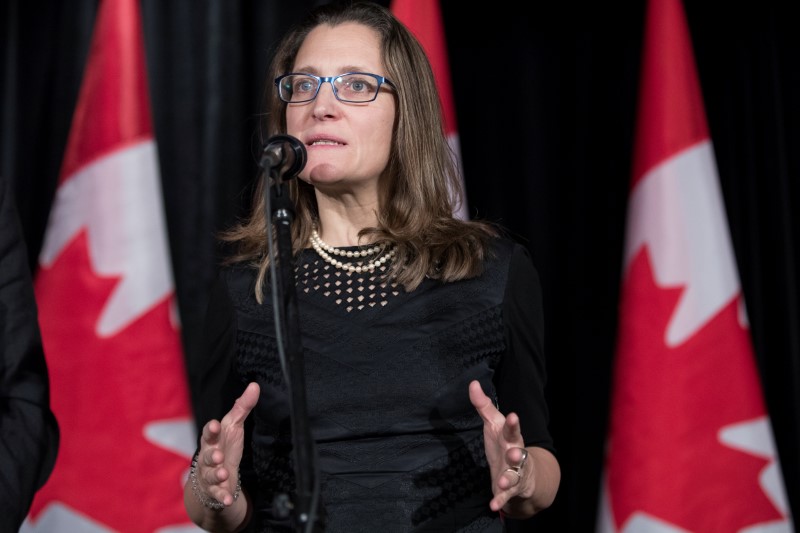By Steve Scherer and Fergal Smith
OTTAWA (Reuters) - Canada has been criticized for years for failing to meet its debt-reduction goals and many economists say Prime Minister Justin Trudeau's Liberal government lacks credibility after repeatedly choosing more spending over fiscal discipline.
Since Trudeau launched massive public spending to soften the blow of the pandemic, the government has committed to bringing down the federal debt as a percentage of gross domestic product (GDP) in the medium term as a signal it is fiscally responsible.
But twice this year Finance Minister Chrystia Freeland has postponed the debt-reduction goals, including last month in the Fall Economic Statement (FES), when it was made clear that the debt-to-GDP ratio would rise two years in a row - this fiscal year and next. So the government outlined new fiscal goals.
"I don't think much of these new fiscal anchors," said Randall Bartlett, senior director of Canadian economics at Desjardins Group. "I don't think they have any value at all, quite frankly."
The new fiscal anchors cap the deficit at C$40.1 billion ($29.5 billion) in the current fiscal year - at about 1.4% of GDP. Another proposes lowering the debt-to-GDP target for the 2024-25 fiscal year relative to its November estimate and keep the ratio declining thereafter, and finally the deficit would be kept from exceeding 1% of GDP from 2026-27.
New spending has been directed to easing the burden of inflation on low incomes, housing supply, and subsidies for green technologies.
The main risk associated with having less fiscal wiggle room is that external factors, including a severe downturn or higher-than-expected debt costs, could rapidly worsen the country's fiscal position, analysts said.
"Rising debt charges force the federal government to forfeit a greater share of their revenues to pay down the debt, taking away spending room for other important initiatives – like healthcare and social services," said Rachel Battaglia, an economist at Royal Bank of Canada (TSX:RY).
Canada's general government net debt, which includes provincial and municipal borrowing but is reduced by pension assets, is the lowest by far among the G7 countries. But its gross debt, at an estimated 106.4% of GDP in 2023, is higher than that of Germany and the UK, IMF data shows.
The U.S. budget deficit was more than 6% of GDP in the 2023 fiscal year, but Canada is a tenth of the size and its dollar is not a reserve currency, so financial markets consider its economy more vulnerable.
Conservative leader Pierre Poilievre has opened a lead of 19 percentage points on the Liberals, the largest recorded by Abacus Data since Trudeau was elected in 2015, in part by blaming inflation on government spending, according to a survey conducted in late November.
The government may want to increase expenditure ahead of the 2025 election, Bartlett said. In 2015, lagging in the polls, Trudeau pledged to run deficits to bolster public infrastructure and won the election.
Then in 2016, Trudeau abandoned plans to balance the budget as well as a goal to reduce the debt-to-GDP ratio to 27%. Amid the economic turmoil of the pandemic, his government racked up Canada's highest-ever deficit and the ratio jumped to as high as 47.5% versus 31.2% in 2019-20, before COVID-19 hit.
"If downside scenarios materialize, assume all anchors are abandoned," said Rebekah Young, head of inclusion and resilience economics at Scotiabank (TSX:BNS). "If anything, these (new fiscal goals) reaffirm the government's comfort with running modest deficits into perpetuity."
While the government has been inconsistent on its debt goals, most ratings agencies still give Canada their top ranking, and other countries are spending more.

"Canada still remains the cleanest dirty fiscal shirt in the closet," Bartlett said, comparing it to other G7 countries. "But we know with each subsequent budget comes new spending ... and all the risks are to the downside."
($1 = 1.3570 Canadian dollars)
